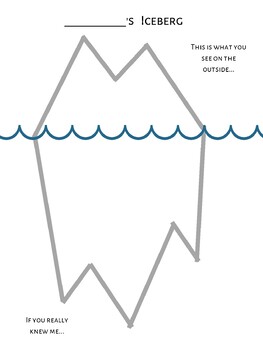


While it sounds like a complicated process with several stages, it can escalate from trigger to outburst surprisingly quickly in the young or someone with limited self-control. Then, finally, potentially out of control, angry, aggressive, or destructive behaviors may begin (Dyer, 2020). If nothing happens to break the process, physical symptoms kick in, such as shaking, sweating, or even feeling sick.
#Anger iceberg template series#
Then, several irrational thoughts start to form, followed by a series of negative emotions. It might be another person’s actions, an event, or even a memory (Dyer, 2020). In her book Anger Management, Judy Dyer (2020) says that it is crucial to break the anger cycle.Įach angry response begins with a triggering event. Note that while frustrating for close family and friends, anger that is out of control rather than normal can indicate serious and deep emotional issues (Travis, 2012). Declining academic standards falling behind the mean for their age.Behavior motivated by payback and revenge.Fits of rage, losing their temper, and becoming highly vindictive in what they say.Getting into altercations and fights with other students.Behaving rudely and disrespectfully to adults.Behavior can be irritable, defiant, and high risk, involving various unhealthy or unhelpful acts, such as (Travis, 2012):
#Anger iceberg template tv#
After viewing particular types of TV shows, movies, or online contentĪdolescent teens are considerably more independent than younger children and express their anger similarly to adults.The chemical composition of the teenage brain is in a constant state of change, with research suggesting angry behavior is associated with a lack of neurotransmitters (Travis, 2012).Īs there are many potential triggers for teenagers, it is important to observe whether related behavior tends to occur at a particular time, such as:
#Anger iceberg template how to#
To help, the caregiver, parent, teacher, or therapist must understand what triggers the anger – whether normal or out of control – and how to teach coping mechanisms to avoid or calm an angry episode. The behavior can be extreme and potentially includes “engaging in acts of substance abuse, misconduct behavior, assault, verbal threats, and sexual behavior” (Travis, 2012, p. Adolescent teenagers show their anger in more grown-up ways, most likely using their developed language and motor skills. Teenage angerĪnger is typically expressed differently depending on the age of the child. While crucial to spot early, parents may be unclear of the cause or triggering factors, and left frustrated regarding how best to help their child (Travis, 2012).įailure to recognize, understand, and resolve this anger can lead to chronic mental health problems, including anxiety and depression (Travis, 2012).

4 Educational Videos for Youth and Students.6 Anger Management Worksheets for Teens.


 0 kommentar(er)
0 kommentar(er)
